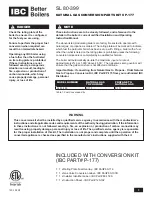
PLEASE READ THIS MANUAL CAREFULLY BEFORE INSTALLING OR USING THE MODULES
PLEASE PASS ALONG THE USER MANUAL TO YOUR CUSTOMER
GENERAL INSTALLATION MANUAL FOR SHARP PV MODULES
INTRODUCTION
This Installation Manual contains essential information for the electrical and mechanical installation that you must know before installing SHARP PV
modules. This also contains safety information you need to be familiar with. All the information described in this manual are the intellectual property of
SHARP and based on the technologies and experiences that have been acquired and accumulated in the long history of SHARP. This document does
not constitute a warranty, expressed or implied. SHARP does not assume responsibility and expressly disclaims liability for loss, damage, or expense
arising out of or in any way connected with installation, operation, use or maintenance of the PV modules. No responsibility is assumed by SHARP for
any infringement of patents or other rights of third parties that may result from use of PV module. SHARP reserves the right to make changes to the
product, specifications or installation manual without prior notice.
GENERAL INFORMATION
(INCLUDING WARNING AND SAFETY)
The installation of PV modules requires a great degree of skill and should only be performed by a qualified licensed professional, including licensed con-
tractors and licensed electricians. Please be aware that there is a serious risk of various types of injury occurring during the installation including the risk
of electric shock. All SHARP PV modules are equipped with a permanently attached junction terminal box that will accept variety of wiring applications
or with a special cable assembly for ease of installation, and they do not require special assembly.
General Warning
1. PV modules are heavy. Handle with care.
2. Before you attempt to install, wire, operate and maintain the PV module, please make sure that you completely understand the information de-
scribed in this installation manual.
3. Contact with electrically active parts of a PV module such as terminals can result in burns, sparks and lethal shock whether the PV modules is
connected or not.
4. PV modules produce electricity when the sufficient sunlight or other sources illuminate the module surface. When the modules are connected in
series, voltage is cumulative. When the modules are connected in parallel, current is cumulative. As a result, a large-scale PV system can pro-
duce high voltage and current which could present an increased hazard and may cause serious injury or death.
5. Do not connect the PV modules directly to the loads such as motor since the variation of the output power depending on the solar irradiation
causes damage for the connected motor.
1: In the case of a brushless motor, the lock function becomes active and the hall IC is most likely to be damaged.
2: In the case of a brush type motor, the coil is most likely to be damaged.
General Safety
1. Consult local codes and other applicable laws concerning required permits on regulations concerning installation and inspection requirements.
2. Before installing a PV module, contact appropriate authorities to determine permit, installation and inspection requirements that should be fol-
lowed.
3. Install PV modules and ground frames in accordance with applicable rules and regulations.
4. PV modules should be installed and maintained by qualified personnel. Only installer/servicer personnel should have access to the PV module in-
stallation site.
5. No matter where the PV modules are installed, either roof mounted construction or any other type of structures above the ground, appropriate
safety practices should be followed and required safety equipment should be used in order to avoid possible safety hazards. Note that the instal-
lation of some PV modules on roofs may require the addition of fireproofing, depending on local building/fire codes.
6. In the case that the PV modules are non-integral type, the module is to be mounted over a fire resistant roof.
7. Please use PV modules with same cell size within series.
8. Follow all safety precautions of other components used in the system.
9. In order to avoid a risk of injury or electrical shock, do not allow anyone to approach the PV module if the person has little knowledge on PV
module or on the measures that should be taken when PV modules are damaged.
10. Do not shade portions of the PV module surface from the sunlight for a long time. The shaded cell may become hot (hot spot phenomenon)
which results in solder joints peeling off.
11. Do not clean the glass surface with chemicals. Do not let water stay on the glass surface of PV modules for a long time. This creates a risk of
white efflorescence (glass disease) which may result in the deterioration of energy generation.
12. Do not install the PV module horizontally. It may cause dirt or white efflorescence (glass disease) due to water cumulation.
13. Do not cover the water drain holes of the frame. There is a risk of frost damage when the frame is filled with water.
14. When sliding snow load has to be considered, an appropriate measure has to be taken so that PV module frames on lower edge of PV modules
will not be damaged.
15. Do not expose PV module to sunlight concentrated with mirrors, lenses or similar means.
16. Turn off inverters and circuit breakers immediately, should a problem occur.
17. In case the glass surface of a PV module is broken, wear goggles and tape the glass to keep the broken pieces in place.
18. A defective PV module may generate power even if it is removed from the system. It may be dangerous to handle the PV module while exposed
to sunlight. Place a defective PV module in a carton so PV cells are completely shaded.
19. In case of series connection, the maximum open circuit voltage must not be greater than the specified maximum system voltage. The voltage is
proportional to the number of series. In case of parallel connection, please be sure to take proper measure (e.g. fuse for protection of module
and cable from over current, and/or blocking diode for prevention of unbalanced strings voltage) to block the reverse current flow. The current
may easily flow in a reverse direction.
Handling Safety
1. Do not cause an excessive load on the surface of PV module or twist the frame. The glass surface can easily break.
2. Do not stand or step on the PV module. The surface glass of PV module is slippery.
3. Do not hit or put excessive load on the glass or back sheet. The PV cell is very thin and can be easily broken.
4. Do not scratch or hit at the back sheet. The back sheet is vulnerable.
5. Do not hit on the terminal box or do not pull the cables. The terminal box can crack and break.
6. Never touch terminal box or the end of output cables with bare hands when the PV module is irradiated. Cover the surface of PV module with
cloth or other suitable sufficiently opaque material to isolate the PV module from incident light and handle the wires with rubber-gloved hands to
avoid electric shock.
7. Do not scratch the output cable or bend it with force. The insulation of output cable can break and may result in electricity leakage or shock.
8. Do not pull the output cable excessively. The output cable may unplug and cause electricity leakage or shock.
9. Do not drill holes in the frame. It may compromise the frame strength and cause corrosion of the frame.
10. Do not scratch the insulation coating of the frame (except for grounding connection). It may cause corrosion of the frame or compromise the
framework strength.
11. Do not loosen or remove the screws of the PV module. It may compromise the joint strength of PV module and cause corrosion.
12. Do not touch the PV module with bare hands. The frame of PV module has sharp edges and may cause injury.
13. Do not drop PV module or allow objects to fall down on the PV module.
14. Do not try artificially to concentrate sunlight on the PV module.
15. Do not grab the PV module at only one side. The frame may bend. Grab the PV module at two sides facing each other.






























